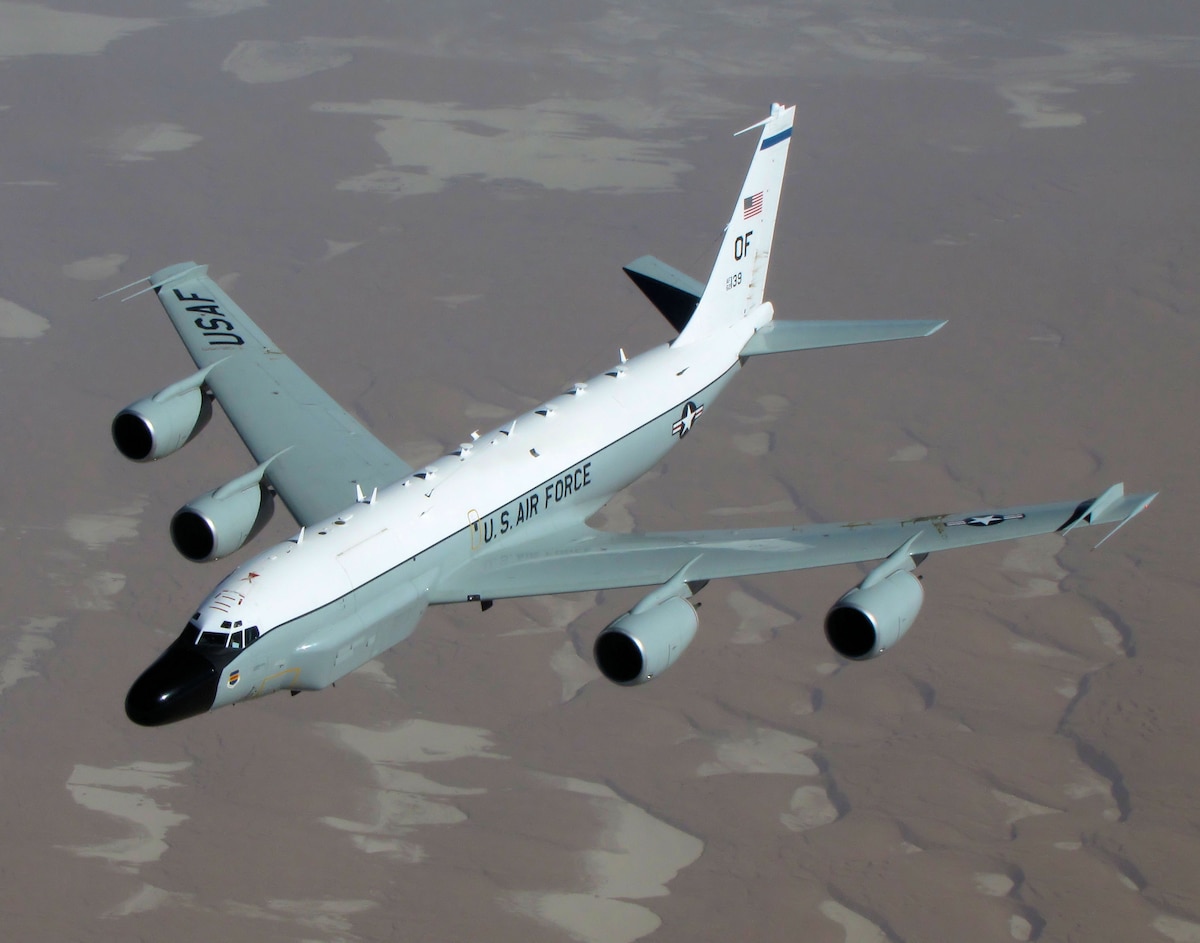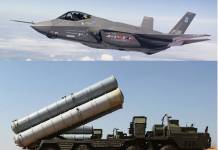The US Air Force deployed its RC-135U reconnaissance aircraft to scan China’s southern coastline, just days after Australia and Canada accused PLA fighter jets of conducting dangerous interceptions.
‘Tail Up & Nose Down’ – Why World’s Best Selling Fighter Jets Are Crashing In A Very Predictable Manner?
According to online flight tracking data, RC-135U aircraft, serial number 64-14849, flew a mission near China’s southern coast on June 6, including around Hainan Island and into the Gulf of Tonkin.
Hainan is home to China’s strategic Yulin Naval Base, where PLA Navy’s nuclear submarines remain docked.
The RC-135U that took off from the Kadena Base in Okinawa in Japan covered almost the entire southern coastline of China that meets the northern end of the South China Sea.
The mission comes after Australia said that its P-8A reconnaissance plane was intercepted by a Chinese J-16, which fired chaff at it over the South China Sea, as previously reported by the EurAsian Times.

Commander of RC-135 aircraft and National Security Historian Robert Hopkins explained that the use of these countermeasures (chaff/flare) by the PLA Air Force can cause physical damage to the intercepted aircraft.
Further, another US ally, Canada, had also accused China of conducting several dangerous interceptions against its aircraft.
Last night, USAF RC-135U Combat Sent 64-14849 flew a collection sortie over the South China Sea, just off the coast of the Southern Theater and Hainan Island. Included are points in China and the South China Sea on areas tagged as "military use" on OpenStreetMaps. #ADSB #AE01D5 https://t.co/EfSFt5SDoT pic.twitter.com/Ufi9WdWbQQ
— Amelia Smith (@ameliairheart) June 6, 2022
Incidentally, the route taken by the RC-135U was similar to one taken by a US Navy EP-3E Aries II, another electronic intelligence gathering platform, when it collided with a People’s Liberation Army J-8 fighter jet back in 2001.
A US Navy EP-3E Aries II had collided with a People’s Liberation Army Navy (PLAN) J-8II interceptor over the South China Sea, 110 kilometers off the coast of Hainan Island, on April 2001.
Mission 2027 – Chinese Military Will Be ‘Ready For Action’ Against Taiwan & Allies In 5 Years – Defense Ministry
While the damaged US fighter made an emergency landing on Hainan Island, the Chinese jet crashed, killing its pilot, Lt. Cmdr. Wang Wei. The US crew destroyed its most classified material before landing in China.
Same USAF RC-135U #AE01D5 is operating along the coast of Guangdong and Hainan now, June 6. Of the US reconnaissance aircraft, RC-135U is perhaps the most aggressive, and its main target is likely to be radars deep in mainland China instead of Chinese maritime activities. https://t.co/fOFIwe3h2p pic.twitter.com/dVecRSpeKn
— SCS Probing Initiative (@SCS_PI) June 6, 2022
On June 3, the same RC-135U had conducted another sortie that took it near locations along much of China’s central and northern coastlines. Both sorties were conducted from Kadena Air Base in Japan.
Along China’s coastlines, particularly around Hainan’s Yulin Naval Base, plenty of radars and other signal transmitters could be of interest to an aircraft like the RC-135U.
US military intelligence, surveillance, and reconnaissance (ISR) aircraft have been spotted flying similar routes in the past, including at least one US Navy P-8A Poseidon maritime patrol jet fitted with a hidden radar pod.
US Surveillance Over China
The mission comes amid rising tensions and a geopolitical contest in the Indo-Pacific region. Apart from intercepting and intimidating Australian and Canadian aircraft, China has been recently accused of building a secret naval facility in Cambodia.
The Ream Naval Base in Cambodia, in the Gulf of Thailand, is allegedly preparing to host an area solely for Chinese use, the Washington Post reported. Even though both sides have refuted these claims, doubts persist.
Over the weekend, however, Just a portion. "Chinese official in Beijing confirmed to The Washington Post that “a portion of the [Cambodia] base” will be used by “the Chinese military.” The official denied it was for “exclusive” use by the military…" https://t.co/9MXhVEO991
— Julian Ku 古舉倫 (@julianku) June 6, 2022
In its recent mission, the RC-135 could potentially have used the route to collect data on various Chinese assets on the Woody and Paracel Islands.
In recent years, the PLA has been expanding its military installations on Woody Island and in the Paracels as part of a larger push to strengthen its capabilities and overall presence in the South China Sea.
Beijing claims almost the whole sea as its sovereign national territory, a position the international community opposes.
China has converted various inhospitable shoals and reefs into fortress-like military outposts. The US Indo-Pacific commander Admiral John Aquilino said earlier that China had fully militarized at least three islands it built in disputed South China.
WATCH: China PLA Navy Type 071 amphibious transport dock Kunlun Shan, Type 072A dock landing ship Laotie Shan, Type 073A landing ship Mount Song conduct simulate amphibious landing and island seizure in South China Sea recently. pic.twitter.com/ShunfMsFi7
— Ryan Chan 陳家翹 (@ryankakiuchan) June 3, 2022
The emergence of the RC-135U off the coast of China comes after a big PLA show of force directed at Taiwan last week.
On May 30, a total of 30 Chinese military aircraft flew into the southwestern corner of the island’s Air Defense Identification Zone (ADIZ). Not just this, it started military drills in the South China Sea as soon as US President Biden embarked on his maiden visit to Asia.
Furthermore, China’s support for North Korea has also irked Washington, which moved a resolution against the belligerent country in the United Nations. The resolution was vetoed by Beijing, as has been the case on previous occasions.
RC-135U
The RC-135Us are highly specialized platforms configured to collect a wide range of signals and other electronic intelligence for the Air Force.
Unlike the larger fleet of RC-135V/W Rivet Joints, which have similar capabilities, these aircraft are primarily used to fulfill national-level technical electronic intelligence (TechELINT) missions.
“Technical ELINT … describes the signal structure, emission characteristics, modes of operation, emitter functions, and weapons systems associations of such emitters as radars, beacons, jammers, and navigational signals,” according to an unclassified National Security Agency monograph.
Aerial refueling is standard on all RC-135U aircraft, allowing them an unrestricted range of flight. The Communication equipment includes Radios with high, very high, and extremely high frequencies.
Ground navigation radar, a solid-state Doppler system, and an inertial navigation system that combines celestial observations with data from the Global Positioning System are all included in the navigation system.

The reconnaissance equipment is slightly different in each aircraft, even though the flight crew stations are similar. The aircraft are distinguished by the antennae arrays on the “chin” and wing tips, as well as the massive cheek fairings and extended tail.
Two pilots, one navigator, two airborne systems engineers, and at least ten electronic warfare officers, or “Ravens,” as well as six or more electronic, technical, and area specialists make up the crew.
The data gathered is vital for the proper design and programming of RWR (radar warning receivers), jammers, decoys, anti-radiation missiles, and threat simulators. Each airframe has its sensor suite.
For navigation, the aircraft uses radar/solid-state doppler, INS, celestial, and GPS and is capable of both manual and automated signal gathering and analysis.
- Contact the author at sakshi.tiwari9555@gmail.com
- Follow EurAsian Times on Google News




